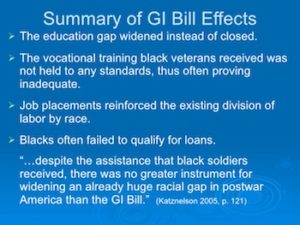
*On this date in 1944, the G.I. Bill was signed into American law. Officially titled the Servicemen's Readjustment Act of 1944 was signed into law by President Franklin Roosevelt.
During World War II, politicians wanted to avoid the postwar confusion about veterans' benefits that became a political football in the 1920s and 1930s. Veterans' organizations that had formed after the First World War had millions of members; they mobilized support in Congress for a bill that provided benefits only to veterans of military service, including men and women. Harry W. Colmery, Democrat and a former National Commander of the American Legion, wrote the first draft of the G.I. Bill.
He reportedly jotted down his ideas on stationery and a napkin at the Mayflower Hotel in Washington, D.C. U.S. Senator Ernest McFarland, Democrat-Arizona, was actively involved in the bill's passage and is known, with Warren Atherton, as one of the "fathers of the G.I. Bill." One might then term Edith Nourse Rogers, R-Mass, who helped write and who co-sponsored the legislation, as the "mother of the G.I. Bill". As with Colmery, her contribution to writing and passing this legislation has been obscured by time.
The bill that President Roosevelt initially proposed had a means test only poor veterans would get one year of funding; only top-scorers on a written exam would get four years of paid college. The American Legion proposal was intended to provide full benefits for all veterans, including women and minorities, regardless of their wealth. A provision of the G.I. Bill was low interest, zero down payment home loans for servicemen, with more favorable terms for new construction compared to existing housing.
This encouraged millions of American families to move out of urban apartments and into suburban homes. Another provision was known as the 52–20 clause for unemployment. Unemployed war veterans would receive $20 dollars a week for 52 weeks for up to one year while they were looking for work. Less than 20 percent of the money set aside for the 52–20 Club was distributed. Rather, most returning servicemen quickly found jobs or pursued higher education. With all of these options, African American veterans have benefited less than others from the G.I. Bill.
On paper, the G.I. Bill aimed to help American World War II veterans adjust to civilian life by providing them with benefits including low-cost mortgages, low-interest loans, and financial support. African Americans did not benefit nearly as much as white-European Americans. Historian Ira Katznelson argues that "the law was deliberately designed to accommodate Jim Crow".
Of the first 67,000 mortgages insured by the G.I. Bill, fewer than 100 were taken out by non-whites. Additionally, banks and mortgage agencies refused loans to blacks, making the G.I. Bill even less effective for blacks. Once they returned from the war, blacks faced discrimination and poverty, which represented a barrier to harnessing the benefits of the G.I. Bill, because labor and income were immediately needed at home.
Most southern university administrators refused to admit Blacks until the American Civil Rights movement became more organized. Segregation was legally mandated in that region. Colleges accepting blacks in the South initially numbered 100. Those institutions were of lower quality, with 28 of them classified as sub-baccalaureate. Only seven states offered post-baccalaureate training, while no accredited engineering or doctoral programs were available for blacks. These institutions were all smaller than white or non-segregated universities, often facing a lack of resources.
Even after admission to universities, public education was in such a poor state for blacks that many of them were not adequately prepared for college-level work. Those who were prepared for college-level work gained admission to predominantly white universities. Remember this was before Brown v BOE (1954) when American public schools were legally segregated.
By 1946, only one-fifth of the 100,000 Blacks who had applied for educational benefits had been registered in college. Furthermore, historically black colleges and universities (HBCUs) came under increased pressure as rising enrollments and strained resources forced them to turn away an estimated 20,000 veterans. Financially, HBCUs were already the poorest American colleges. HBCU resources were stretched even thinner when veterans’ demands necessitated an expansion in the curriculum beyond the traditional "preach and teach" course of study. Though Blacks encountered many obstacles in their pursuit of G.I. benefits, the bill greatly expanded the population of Blacks attending college and graduate school. In 1940, enrollment at Black colleges was 1.08% of total U.S. college enrollment. By 1950 it had increased to 3.6%.
Additionally, the bill led to the passage of the Lanham Act of 1946, which provided for federal funding for the improvement and expansion of HBCUs. However, these gains were limited almost exclusively to Northern states, and the educational and economic gap between white and black nationally widened under the effects of the G.I. Bill. With 79 percent of the black population living in southern states, educational gains were limited to a small part of African America.